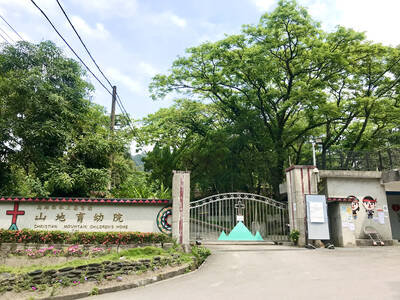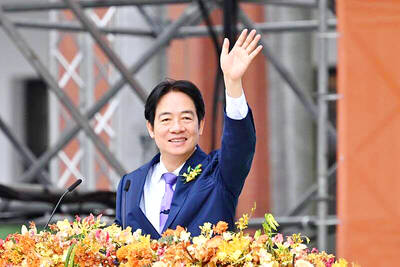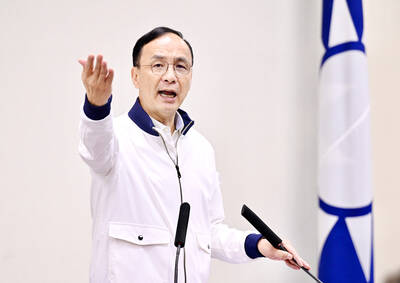Hardcore gardeners sometimes, when no one else is listening, talk quietly to their prize blooms. But at next year’s Chelsea flower show, visitors will be encouraged to have a chat with its first ever AI-powered garden.
The garden designer Tom Massey has partnered with Microsoft to create the Avanade “intelligent” garden. Sensors in the soil are partnered with an AI trained on Royal Horticultural Society plant data and gardening advice, meaning visitors can ask the garden: “How are you?”
Massey said: “It could answer: I need a bit more water, I can do with a haircut, maybe.”

Photo: AFP
As well as making gardening easier and more fun, Massey said it could have wider applications. The wireless sensors hidden in the soil measure moisture, nutrient levels, acidity and alkalinity. These will connect to a computer in a pavilion in the garden, which people will be able to consult to see how the garden is doing.
“It’s supposed to be interactive,” Massey said. “It’s supposed to be showcasing this really kind of new emerging technology, and also saving resources.”
He said the simple sensor technology could be rolled out across large estates, so rather than having automatic watering systems which switch on depending on the time, the plants are only watered when the soil moisture drops below a certain level.
“We are wasting so much water and London is at risk of running out of water in coming years,” he said. “Imagine how much water you could save in a big development if you only use water when needed. Irrigation systems come on at a regular time to water, whether it’s needed or not.”
The garden itself would not be futuristic in its design, he said. “We wanted it to feel green and organic and earthy.” It will feature mushrooms as well as climate-resilient trees, which will be monitored by an AI assistant, and lots of peaceful green planting.
The RHS has adapted its system to be as energy efficient as possible. Jon Simpson, the society’s director of IT, said: “With AI, you do have the question of, does it consume more energy using data centers, so yes it can be detrimental but it’s about how you use it. What we are doing is training more traditional AI models against the RHS database, which is basically called a small language model, which is far more efficient and effective.”

May 18 to May 24 Pastor Yang Hsu’s (楊煦) congregation was shocked upon seeing the land he chose to build his orphanage. It was surrounded by mountains on three sides, and the only way to access it was to cross a river by foot. The soil was poor due to runoff, and large rocks strewn across the plot prevented much from growing. In addition, there was no running water or electricity. But it was all Yang could afford. He and his Indigenous Atayal wife Lin Feng-ying (林鳳英) had already been caring for 24 orphans in their home, and they were in

On May 2, Chinese Nationalist Party (KMT) Chairman Eric Chu (朱立倫), at a meeting in support of Taipei city councilors at party headquarters, compared President William Lai (賴清德) to Hitler. Chu claimed that unlike any other democracy worldwide in history, no other leader was rooting out opposing parties like Lai and the Democratic Progressive Party (DPP). That his statements are wildly inaccurate was not the point. It was a rallying cry, not a history lesson. This was intentional to provoke the international diplomatic community into a response, which was promptly provided. Both the German and Israeli offices issued statements on Facebook

President William Lai (賴清德) yesterday delivered an address marking the first anniversary of his presidency. In the speech, Lai affirmed Taiwan’s global role in technology, trade and security. He announced economic and national security initiatives, and emphasized democratic values and cross-party cooperation. The following is the full text of his speech: Yesterday, outside of Beida Elementary School in New Taipei City’s Sanxia District (三峽), there was a major traffic accident that, sadly, claimed several lives and resulted in multiple injuries. The Executive Yuan immediately formed a task force, and last night I personally visited the victims in hospital. Central government agencies and the

Australia’s ABC last week published a piece on the recall campaign. The article emphasized the divisions in Taiwanese society and blamed the recall for worsening them. It quotes a supporter of the Taiwan People’s Party (TPP) as saying “I’m 43 years old, born and raised here, and I’ve never seen the country this divided in my entire life.” Apparently, as an adult, she slept through the post-election violence in 2000 and 2004 by the Chinese Nationalist Party (KMT), the veiled coup threats by the military when Chen Shui-bian (陳水扁) became president, the 2006 Red Shirt protests against him ginned up by